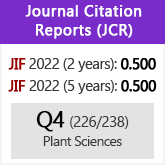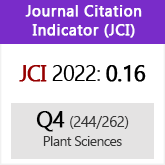Ecotypic and allozyme variation of Capsella bursa-pastoris and C. rubella (Brassicaceae) along latitude and altitude gradients on the Iberian Peninsula
DOI:
https://doi.org/10.3989/ajbm.1999.v57.i2.204Keywords:
Allozymes, ecotypic differentiation, fruit dimensions, growth forms, leaf morphology, onset of flowering, plant height, Capsella, Brassicaceae, SpainAbstract
Life-history traits (onset of flowering, leaf number, rosette diameter, plant height, branching number, fruit dimensions, seed number) of Capsella species from the Iberian Península associated with colotúzing ability were compared in a random block field experiment. Data were evaluated by a principal component analysis. Allozymes (AAT, LAP, GDH) and leaf types were recorded. C. bursa-pastoris plants originating from low and high elevations of the summer dry Mediterranean climatic zone (Sierra Nevada) were early flowering, whereas those originating from the Pyrenees with an alpine climate were late. In C. bursa-pastoris the "rhomboidea" leaf type was very frequent, whereas in C. rubella it was the "heteris" leaf type. There was a change of leaf type frequencies along geographical clines which is explained by adaptive components of the leaf shape. The allozymes displayed a geographical distribuüon pattem and in C. bursa-pastoris a certain multilocus genotype appeared to be a molecular marker for an early flowering ecotype
Downloads
Download data is not yet available.
Downloads
Published
1999-12-30
How to Cite
Neuffer, B., & Hoffrogge, R. (1999). Ecotypic and allozyme variation of Capsella bursa-pastoris and C. rubella (Brassicaceae) along latitude and altitude gradients on the Iberian Peninsula. Anales Del Jardín Botánico De Madrid, 57(2), 299–315. https://doi.org/10.3989/ajbm.1999.v57.i2.204
Issue
Section
Articles
License
Copyright (c) 1999 Consejo Superior de Investigaciones Científicas (CSIC)

This work is licensed under a Creative Commons Attribution 4.0 International License.
© CSIC. Manuscripts published in both the printed and online versions of this Journal are the property of Consejo Superior de Investigaciones Científicas, and quoting this source is a requirement for any partial or full reproduction.All contents of this electronic edition, except where otherwise noted, are distributed under a “Creative Commons Attribution 4.0 International” (CC BY 4.0) License. You may read here the basic information and the legal text of the license. The indication of the CC BY 4.0 License must be expressly stated in this way when necessary.
Self-archiving in repositories, personal webpages or similar, of any version other than the published by the Editor, is not allowed.
















